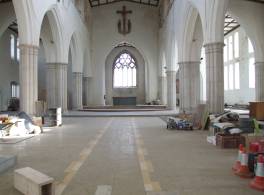Art has been part of church life for centuries, and art in our churches takes many forms. It helps us connect with God and reflect our faith.
New art should always be created for a specific place in your church building, and with an understanding of its purpose in supporting people’s faith.
We can guide you through the process of commissioning new art for your church.
Download our guidance
- New glass for your church (423.81 KB)

Decide what you want and set up a group
So you want a new piece of art in your church?
Agree what you want and where to install the artwork before asking an artist to come up with an idea. You don’t need to go into fine details, but you should know if you want a sculpture, a painting, or maybe what subject or topic it needs to convey.
Set up a small group of people to manage the project and make decisions. Each member should have a specific role.
Remember:
You don’t have to accept a new piece of art in your church just because someone offers it to you. Follow these steps to find out if it is the right artwork for you and your church.
Write a brief
The brief should explain the purpose and aims of the commission without holding back the artist’s creativity. Include:
- What you want
- Where you want to put it
- The material or medium of the artwork
- Its content or theme (e.g. theological or liturgical)
- The amount of money available
- And the commissioning process
Share your brief with a few artists and include a copy of your statement of significance and needs. The artists should understand the history and importance of your church.
Make them aware of any laws that they will have to follow (e.g. ecclesiastical law requires that chalices and patens are made of gold, silver or another suitable metal).
Choose an artist
To find an artist, talk to:
- Your Diocesan Advisory Committee
- Local museums, art galleries, public art officers and university art departments
- A specialist commissioning agent or consultant
- Or you could run a competition
To choose your artist, compare the proposals and ask yourself:
- Does their work look right in your building?
- Have they met your brief?
- Have you talked to people to see what they think? (e.g. DAC, PCC, congregation, local community, etc.)
- Have you visited other sites with this artist’s work, to see what it is like in real life and to talk to people there about the commissioning process?
- And are you still happy to go ahead?
Get permission
You need a faculty to install new art in your church building.
Ask the artist for the following documents and send them to your DAC early on for advice:
- A statement explaining how they have responded to your brief
- A technical statement
- Scale drawings or models
- A note explaining if the artwork has special care requirements
Your DAC will tell you if you need to consult anyone else, including the Church Buildings Council.
Warning:
Only once the faculty is granted and funding in place can work start!
Contact your insurer
Avoid unexpected surprises and contact your insurance company as early as possible.
They will advise you on security or preventative measures they might think necessary.
It might not cost you anything to add the artwork to your insurance cover.
Temporary art
Temporary art is another way you can engage worshippers and visitors with the church and its life. It can take many forms and there are many ways you can use it.
Have a clear idea of what you want to achieve and follow the same steps.
New Stained Glass
Proposals for new windows are more frequent than for any other type of art. But the process for commissioning them is the same.
- Write a statement of significance and needs
- Prepare a brief
- Find an artist
- Get your permissions
Before you start, ask yourself if new stained glass is really the best option. Another type of artwork might be better. You should talk to your DAC for advice.
Warning:
It is not a good idea to take a design on paper and then ask a glass maker to turn it into stained glass.
Stained glass design needs someone who is used to using it and who knows how the design relates to the way the glass will be made.
Case studies
- Portable artwork at Wednesfield church (471.32 KB)
- New sculpture at St Andrew Plymouth (2.11 MB)

